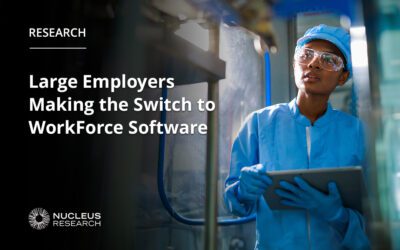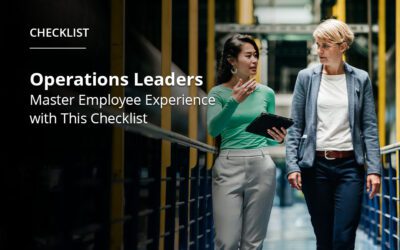EX Design Requires a Full Org Press – Employee Experience is Everyone’s Responsibility

The COVID-19 pandemic has had an unprecedented effect on every aspect of peoples’ lives, including their workplace. The upheaval has turned standard workforce practices completely on their heads, and many standard protocols have had to be reconsidered. Companies have been forced into implementing significant changes including how, where, and when employees work. The situation has been so serious that organizations in some cases have needed to consider whether operations could continue at all.
While many workers view these changes as negatively impacting their careers, others see it as an opportunity to pursue a different or completely new career path. The so-called Great Resignation spurred by the pandemic has already seen millions of Americans walking out on their jobs, with 50% of workers contemplating leaving their current positions and 60% considering new career choices.
As a result, employers have been tasked to rethink, refresh, and redesign the employee experience. This point is reinforced by recent survey findings that reveal 92% of polled Human Resources (HR) leaders view employee experience (EX) as a top priority moving forward in 2022.
Recent trends have shown that people want to work for organizations that care about them and go the extra mile to promote opportunities for success. Employees are looking for organizations that offer a nurturing workplace, where they enjoy their roles and feel fully supported as they strive to go above and beyond. Organizations that reward employees beyond their salaries—such as career development opportunities and flexible work policies—are seen as offering a more holistic approach to work-life balance, which is highly regarded by most individuals.
What are the important factors that motivate your workforce? What interactions are keeping them satisfied and fulfilled in their roles? Leadership, organizational structure, career mobility, development, recognition, and well-being all influence your workers’ employee experience. Improving that is not only the entire organization’s responsibility, but also to its benefit.
“Employee Experience isn’t an HR thing… it’s an everyone thing”, says author and business futurist Jacob Morgan. “There’s a unique opportunity for different functions to come together to truly put people front and center.” It’s in every department’s best interest to collaborate and make persuasive justifications for improving employee experience (and using software to facilitate it). Here’s what key team brings to the table and why they should be part of the process:
HR Leads the Charge in Designing Employee Experience

From initial recruitment and onboarding to the offboarding and exit phase, no other department understands employee matters quite the way HR does.
With employment strategies shifting focus from processes to people, HR executives play a vital role in creating, guiding, and maintaining employee experiences at all touchpoints. Not only does the department have a deep and qualified understanding of company processes, they’re also the most aware of how employees react to those processes.
Before improvements can be implemented, HR must identify where employee experience is lacking. While employee engagement strategies tend to be reactive, employee experience is a proactive practice. HR should determine employment experience (EX) goals, map the worker’s journey, and then plan their EX design approach.
HR should also examine where work may have a negative impact on employees’ lives and find solutions to reduce that burden where possible. Integrating technological processes that support employees to be more efficient can often help in making these difficulties smoother for all parties involved. This includes automating processes where possible and ensuring they have fast and easy access to the information they need.
For an example case, consider our customers at Converse (the iconic sneaker and apparel brand). They were having concerns about their communication channels with their partner retailers and whether they were receiving important corporate brand correspondence. These internal communiques were being sent via email, but they had no method of knowing if and when the messages were being received, reviewed and implemented. WorkForce Experience addressed their issues by streamlining their communications with better tools to monitor and connect.
To get to the essence of retaining talent, HR’s traditional ‘compliance and transaction’ role must evolve to include supporting employees and representing their best interest as an ‘advocate’ when engaging with the company’s leadership. Departments still hanging on to a ‘getting what we need’ mentality must evolve and adopt a more empathetic approach by having personal conversations that can render more people-centered processes.
As the world becomes exponentially more connected, the line between work and personal life is becoming increasingly blurred. HR departments are beginning to use this to their advantage, in a positive way, by optimizing the level of engagement that can be achieved via employees’ personal devices. Tasks that previously would have required multiple contacts and unaffiliated applications are now accessible to employees directly through one easy-to-use platform. These changing paradigms open an entirely new realm of possibilities and capitalize on them to attract, engage, retain, and incentivize employees.
It’s critical for leadership and executives to understand that HR is a strategic partner that has access to valuable insights from employees. Be open-minded, embrace employee positive and negative feedback, and take recommendations from HR to reach EX goals.
IT Builds the Infrastructure for Better Employee Experience
While HR’s focus is on understanding employees at a human level, the role of the IT department is to make use of helpful technology and how employees can benefit from a proficient, current, and savvy tech implementation.
Despite the integral role IT plays in EX design, only 41% of IT leaders cite the improvement of employee experience as a priority. To draw and retain talent, this has to change. To resolve the conflicts that are creating The Great Resignation, there is not only a need for more flexibility but also more commitment from organizations towards employees and their work experience.
Technology plays an integral part in making information accessible, maintaining productivity, and enhancing communication. Poor infrastructure, management, and IT strategies can hamper an employee’s ability to work efficiently and negatively impact their feelings of worth and engagement.
A Gartner survey revealed that with the pandemic-induced digital work environment changes, employees feel more confident with the use of technology. Over half of the survey participants considered themselves proficient in the use of digital tech while 18% said they considered themselves experts.
For reasons far more numerous than only EX design, it is imperative in today’s ever-changing competitive markets that companies invest in updated worforce management technology. With a large deskless shift-based workforce, IT departments play an important role in keeping organizational operations running smoothly. IT can make it easy for workers to access the information they need yet make it simple to keep corporate information safe, for example by providing employees with cyber-threat training and implementing strategies to monitor and manage cyber risks on a mobile app.
When employees have the tools they need to be masters of their work and effectively use these tools for maximum benefit, their self-worth, work satisfaction, and performance rise. Getting the help they need, when they need it, is a vital part of IT’s service to employees.
Operations Ensures All Stakeholders Are Aligned with Employee Experience Strategies
People Operations—the strategic business function that aims to humanize impersonal systems, improve employee development, engagement, satisfaction, and retention— should be focused on putting the employee first.
Though HR and People Operations work closely together, they are not interchangeable. Whereas HR focuses largely on compliance, reducing liability, reactively responding to issues, and maintaining databases, People Ops is more proactive, focusing on company culture. It aims to maximize employee value, create reward systems that enhance productivity, and offer support to reduce turnover.
Companies have traditionally addressed issues such as employee engagement, culture, recognition, and career development as separate programs. Today’s employees see things differently. The modern workforce views everything that happens at work as an integrated experience that impacts their lives in and beyond the workplace. This includes their overall professional, financial, and emotional well-being.
In mapping the employee lifecycle, People Ops will examine how realistic the goals and commands of the company are and identify the milestones that matter to employees. These may include orientation, training, team events, and performance rewards. It is important that the employee continues to feel included and supported throughout their journey with the company to cultivate consistency and confidence in the employer.
People Ops should not only define the company culture but also set clear expectations and boundaries. Transparent processes build trust that contributes to healthier work cultures. A key priority for the People Ops department involves bringing together company goals with individual performance. This entails designing the work environment in a way that fosters engagement, spurs development, and makes employees excited to be there.
Integrating a People Ops model into your business and employee experience strategy offers a holistic approach and can help minimize complications and lawsuits filed by employees. If you don’t yet have a People Ops department, a good starting point is to employ one manager for every 30-50 employees within the beginning stages of your organization. A well-established organization may even form a new team from your existing HR department or hire an external specialist to manage your organization’s employee lifecycle.
Recognition and Rewards
Implementing reward systems and building on a culture of appreciation can boost employee performance, retention, and profits.
Organizations with a culture of appreciation and recognition have shown a 31% lower employee turnover rate than those that do not prioritize employee efforts. Around 40% of employees agree that a major reason for lack of motivation at work is the absence of recognition and appreciation.
Professional Development
A great way to foster employee appreciation is by giving employees the opportunity to grow their skills and develop within their roles. This could also entail career pathing, leadership development, and encouraging employees to think about their own developmental goals. Investing in employee growth is a smart leadership move that has been proven to encourage retention and promote a positive, collaborative work environment. The key is finding ways to implement development opportunities that help your employees build and master those skills they need to do their best work.
To ensure healthy working relationships within the company, it’s important that employees have clear and open communication channels. Establishing frequently used channels where team members can discuss the impact of their work and ways they feel they can improve promotes a sense of ownership within their roles. This can be done by shifting your modes of communication with short, occasional check-ins. Solutions making use of an app can also help give structure to this type of interaction by providing easy accessibility by employees through their personal devices.
Mental Health and Well-Being
A unique role that People Ops undertakes is ensuring the well-being of employees. This is something traditional HR has largely lacked and speaks to the ‘people’ aspect of employee management. Keeping staff healthy should be of the utmost importance, as worker health has unanimously been found to optimize performance and reduce absenteeism.
Trust
Despite performing numerous important tasks, the functions of People Ops departments really boil down to one main underlying goal: gaining employee trust.
Distrust can easily be the result of a lack of communication. Transparency is paramount, especially during the early stages of the employee journey when trust should be an important building block at the onboarding stage.
Employee Experience is Everyone’s Responsibility

At the height of the pandemic, massive debates raged on about the prospects of many laid-off workers to be rehired once economies rebound. Come 2022, and a new set of challenges have emerged. The Great Resignation that has affected every level of industry has had employers scrambling to hold on to the employees that have remained.
The truth has been revealed again and again: the greatest asset any company has is its people. It is also a lesson that, sadly, some organizations are forced to relearn periodically. When an employee doesn’t feel appreciated or does not feel they have room for career growth, the entire organization suffers. Those negative attitudes can reflect in the employees’ work, perhaps permeating the entire organization.
Meanwhile, when employees are given the freedom and agency to work effectively, they thrive along with their employers. By evaluating what support their teams need in order to best perform their work, organizations remain ahead of the curve. To defeat long term problems of stagnation and disengagement, businesses must remain perceptive to the needs of their teams.
Managing employee experience can improve employee retention, save money and time in dealing with unnecessary employee turnover, and make new recruitments easier. However, pre-pandemic EX strategies are of little significance today. Employees who are demanding flexibility, work-life balance, and a reasonable wage will not only have no time for employers not looking out for their best interests, but also have plenty of other competing options.
A positive employee experience has emerged as the new contract between employer and employee. Borrowing from marketing teams who have moved beyond the narrow confines of customer satisfaction to look at customer experience as a whole, HR departments are building EX strategies that speak to the continuous improvement of the overall employee experience with comprehensive EX designs. Keeping employees happy and meeting their needs is now more important than ever. It is no longer the role of a single HR department, but EX design comprises an all-hands approach by IT and Peoples Ops departments as well.
WorkForce Software makes it possible for your organization to refine its EX strategy. The WorkForce Suite adapts to each organization’s unique needs regardless of location, schedules, and labor terms to ensure a breakthrough employee experience where and when it matters most.
How does WorkForce do this?
1. Improved Communication Tools for Better EX Design
Employees rate effective collaboration tools amongst their top priorities to work effectively, and the WorkForce Suite is designed to meet those needs facilitating an informed and engaged workforce.
WorkForce Software offers a simplified yet secure communication tool accessible to employees. It enables real-time, two-way communication with direct messaging so teams can share important announcements, the latest news, and project formation. These capabilities help strengthen workplace bonds by giving employees a place to collaborate, celebrate success, and share best practices.
2. Access to Employee and Company Information
Set your employees up for success by giving them 24/7 access to checklists, operating procedures, visual guidelines, and templates. WorkForce Software offers your company a hub to store and share documents with versioning control so that documents are HQ-approved and updated.
Instant access to critical information from any remote working location improves efficiency and timely work completion. Accessibility permissions can also be set up according to roles or departments showing only relevant information to employees.
3. Focus on Moments That Matter
WorkForce Software offers modern workforce management solutions that enable you to create moments that matter for your employees. Gather staff feedback and act quickly to make modifications where necessary, request event, operational, or role-change feedback, and send out automated surveys to give employees a voice. Easy access and analysis of this information allow management to make informed decisions faster, pinpoint trends, and make strategic adjustments.
WorkForce Software Makes Managing The Deskless Workforce Cost-Effective and Rewarding

WorkForce Software is helping some of the world’s most innovative organizations optimize their workforce, protect against compliance risks, and increase employee engagement to unlock new potential for resiliency and operational performance. The WorkForce Suite adapts to your organization’s specific workforce management requirements no matter how unique your pay rules, labor regulations, schedules, and employee self-service needs.
Chat with WorkForce Software today and find out how to enhance employee experience efforts with a customized plan to suit your unique organization’s needs — and read our Employee Experience Guide for a path to improving employee experience for your workforce.
Subscribe to The WorkForce Blog
Learn the art and science of maintaining productive, happy, engaged employees.
Discover More
Nucleus Insights from WorkForce Customers Research Note
Nucleus Research interviews WorkForce customers who validate why we’re ranked the #1 WFM enterprise vendor for 10 consecutive years.
Elevate Employee Experience: Checklist for Operational Leaders
Get the practical steps and technology functionalities operation leaders need to improve their employees’ work experiences.
Streamlining Complex Workforce Compliance Requirements Boosts Productivity
Discover how workforce compliance software helps EMEA organisations navigate complex legislation, enhance compliance and boost operational efficiency.



